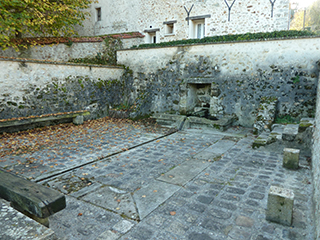Prochain point : lat="49.050445" lon="1.847603"

The Pissotte Wash House
The name indicates a place located near a spring, fountain or stream...
This nineteenth-century wash house used to have a roof...
This wash house at the edge of the village must have been built earlier than 1877, since this is the year when the first repairs to it were recorded in the commune's records. More repairs were carried out in 1895. The wash house underwent considerable modification and the tank has disappeared. All that remains of it are the large stone slabs on the ground. Conversely, the fountain that fed it is still there. Today, the yard is paved with square stones cemented together and large flat stones forming a kind of demarcation.
In 1882, the roof was tiled with tiles that probably came from the nearby tile factory in Frémainville. For many years, the tile factory was the commune's only real industry. According to the school teacher's monograph on the commune, the wash house roof had already disappeared by 1899.
...that was tiled with locally-manufactured tiles.
The manufacture of tiles requires abundant clay deposits (often on the plains), sand, water and heat. The proximity of the Galluis Wood meant there was plenty of fuel for the fires needed to bake the tiles. According to the stewardship plans from the late eighteenth century, there were tile factories in places such as Arthies, Avernes, Jambville, Jouy-le-Moutier and Frémainville.
Some of the local place names – e.g. La Tuilerie and Le Trou Chaud – bear witness to their presence.





